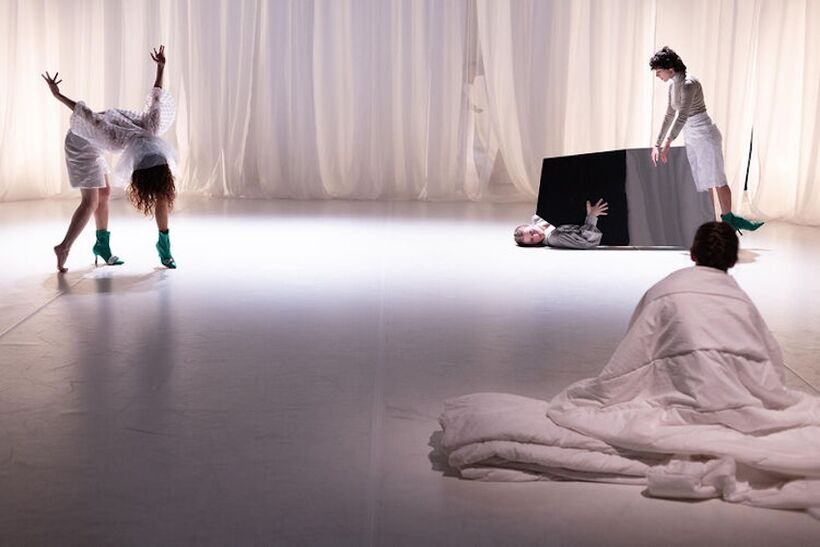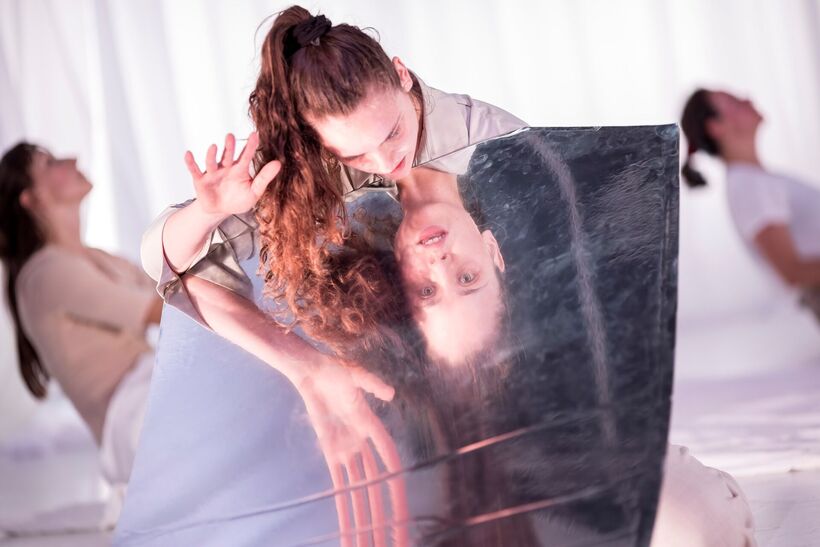Fairy Tales - The Search for Authenticity Under the Layer of Roles
I was used to seeing purely feminine themes on the Czech stage, usually in the form of very intimate, personal stories performed by charismatic dancers and performers. I vividly remember Markéta Vacovská’s Separation about coming to terms with the loss of a child, Ridina Ahmed's Lard about body shaming, Becka McFadden’s Black Dress about the search for gender identity. On a more abstract level, the unwanted pregnancy of the young Marie was the subject of Markéta Jandová's F*cking Beautiful Spring, while the shabby image of the Virgin Mary in a dilapidated chapel was the inspiration for Johana Pocková’s spiritual Madonna with Rust.
It was Pocková and Sabina Bočková, under the banner of PocketArt, with a wider team (choreographic coaching by Peter Šavel, dramaturgy by Viktor Černický), who prepared the opus Fairy Tales for eight young dancers, whose Czech premiere took place in the Ponec Theatre as part of the Tanec Praha festival. The inspiration for the creators was, as the performance title suggests, fairy tales and the depiction of female heroines in them. Prejudices and expectations that shape the fragile souls of children and cause them to grope for their own authenticity under the weight of social roles. Thus, the performance logically featured women’s shoes (shoes on a giant platform with a very high heel), dresses, gloves, mirrors and an apple (of sin). Of the heroines, I spotted a little mermaid, a Coppelia puppet, and a prototype of evil stepmother/queen. The memory of reading fairy tales before bedtime was also evoked by the quilts, which may have slightly suggested a nightmare scene with the transformation of the performers into various creatures but perfectly fulfilled their purpose at the end of the picture of a safe hiding place in one's own interior from the expectations of the surroundings.
The innocence of a child’s soul was evoked throughout most of the piece by the minimalist, bare, white set (with a white dance floor and lightweight sheer curtains in several layers along the sides and back of the stage). The whole thing took on a contrasting deep red as Eva Mora González bit into a red apple with a confident, almost challenging expression. As if by the turn of magic wand (in this case, by repeatedly banging a metal baseball bat into the ground), this caused the shy girls to transform into animalistic females. Their movement vocabulary was suddenly characterized by haphazard kicks of their feet in heels with their bodies bent forward with their hands resting on the ground or stomps synchronized with bat strikes. The women transformed into various creatures of the animal kingdom. They completed their rampage by uttering various animal sounds (cooing, mewing, growling) and accompanying gestures and movements.
 For most of the opus, the dancers were allowed to play with different ideas of femininity independently. At any moment, the viewer could thus observe multiple micro-stories playing out on stage, with attention flitting between them. Jitka Čechová, an exaggeratedly winking and mouth-puckering coquette, Monika Szpunar laughing hysterically and even frighteningly, Eva Mora González moving puppet-like, Tereza Krejčová running around awkwardly. The creative team's intention was probably to highlight the variety of female roles.
For most of the opus, the dancers were allowed to play with different ideas of femininity independently. At any moment, the viewer could thus observe multiple micro-stories playing out on stage, with attention flitting between them. Jitka Čechová, an exaggeratedly winking and mouth-puckering coquette, Monika Szpunar laughing hysterically and even frighteningly, Eva Mora González moving puppet-like, Tereza Krejčová running around awkwardly. The creative team's intention was probably to highlight the variety of female roles.
I confess that at some points, I missed a greater emotional appeal in the form of a synchronous representation of one chosen position of femininity. However, the piece was all the more intense in its conclusion, when the dancers threw all that they considered to be the residual accretions of their authentic selves into one pile in an imaginary fire and spun around in a whirlwind of interconnectedness.
There are a few moments here that I will remember for a long time, and perhaps not coincidentally, since it’s solos on the empty stage. For instance, how Tereza Holubová transformed from a mermaid (when the fin is simulated by the quilt in which her feet are trapped) to a girl; Karolina Gracy’s sadness when she loses the luxurious fur coat from the pile of blankets that gave her confidence; the haunting scenes when the green low boots give the impression that the dancers have multiple limbs; or the girls’ introspective glances into the mirrors, with their backs to the audience…
Fairy Tales is a strongly visual work that spins your imagination. Live music, in which the captivating voice of Never Sol stands out, characteristically completes the atmosphere. However, this piece didn’t resonate as strongly in me as PocketArt’s previous works, such as The Lion’s Den and Treatment of Remembering.
Written from the Czech premiere on 4 June 2024, Ponec Theatre.
Fairy Tales
Choreography, direction: Sabina Bočková, Johana Pocková
Interpretation, creation: Aneta Bočková, Jitka Čechová, Michaela Dzurovčínová, Eva Mora
González, Karolina Graca, Tereza Holubová, Tereza Krejčová, Monika Szpunar
Dramaturgy: Viktor Černický
Choreographic coaching: Peter Šavel
Music: Lukáš Palán, Sára Vondrášková (Never Sol)
Scenography, costumes: Vendula Tomšů
Light design: Eliška Kociánová
Premiere: 26. 4. 2024, festival Sismògraf, Olot, Spain




